Serving 1,994 students in grades 9-12, Jackson-reed High School ranks in the top 30% of all schools in District Of Columbia for overall test scores (math proficiency is top 50%, and reading proficiency is top 50%).
The percentage of students achieving proficiency in math is 18% (which is lower than the District Of Columbia state average of 19%). The percentage of students achieving proficiency in reading/language arts is 54% (which is higher than the District Of Columbia state average of 31%).
The student:teacher ratio of 14:1 is higher than the District Of Columbia state level of 11:1.
Minority enrollment is 64% of the student body (majority Black and Hispanic), which is lower than the District Of Columbia state average of 87% (majority Black).
Quick Stats (2025)
- Grades: 9-12
- Enrollment: 1,994 students
- Student:Teacher Ratio: 14:1
- Minority Enrollment: 64%
- Graduation Rate: 93% (Top 20% in DC)
- Overall Testing Rank: Top 30%
- Math Proficiency: 18% (Top 50%)
- Reading Proficiency: 54% (Top 20%)
- Science Proficiency: 11% (Top 50%)
- Source: National Center for Education Statistics (NCES), DC Dept. of Education
Top Rankings
Jackson-reed High School ranks among the top 20% of public schools in District Of Columbia for:
Category
Attribute
Reading/Language Arts Proficiency
Graduation Rate
Diversity
School Overview
Jackson-reed High School's student population of 1,994 students has grown by 11% over five school years.
The teacher population of 140 teachers has grown by 19% over five school years.
Grades Offered
Grades 9-12
(No virtual instruction)
(No virtual instruction)
Total Students
1,994 students
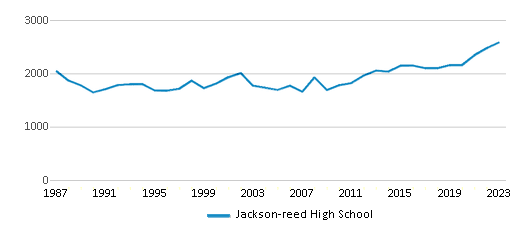
Gender %
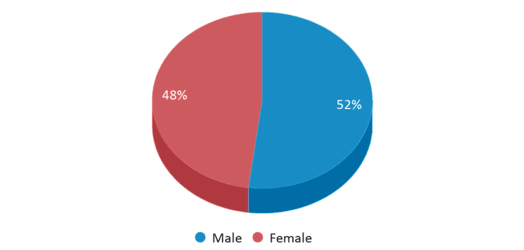
Total Classroom Teachers
140 teachers

Students by Grade
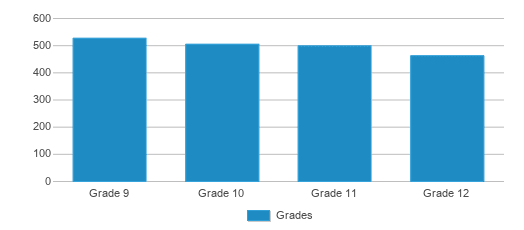
School Rankings
Jackson-reed High School ranks within the top 30% of all 220 schools in District Of Columbia (based off of combined math and reading proficiency testing data).
The diversity score of Jackson-reed High School is 0.73, which is more than the diversity score at state average of 0.55. The school's diversity has stayed relatively flat over five school years.
Overall Testing Rank
#49 out of 220 schools
(Top 30%)
(Top 30%)
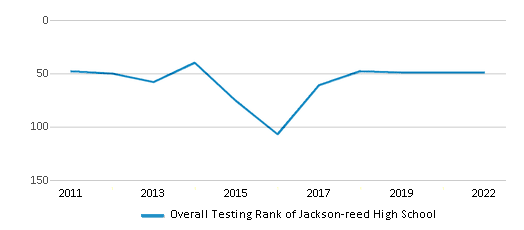
Math Test Scores (% Proficient)
18%
19%
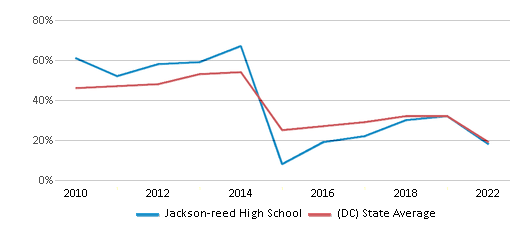
Reading/Language Arts Test Scores (% Proficient)
54%
31%
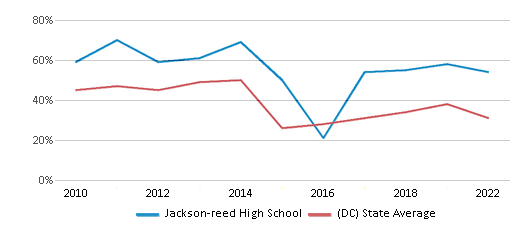
Science Test Scores (% Proficient)
11%
10%
Student : Teacher Ratio
14:1
11:1
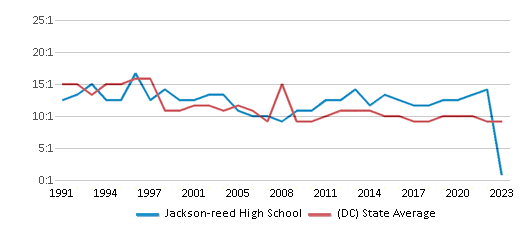
American Indian
n/a
n/a
Asian
6%
2%
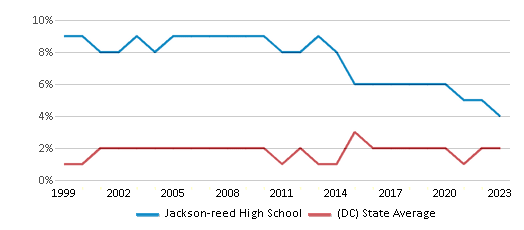
Hispanic
26%
19%
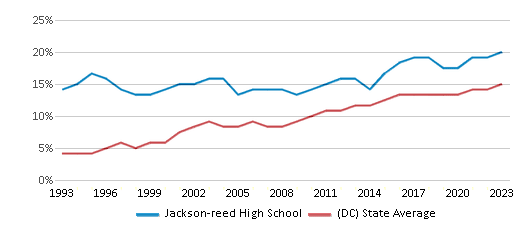
Black
28%
63%
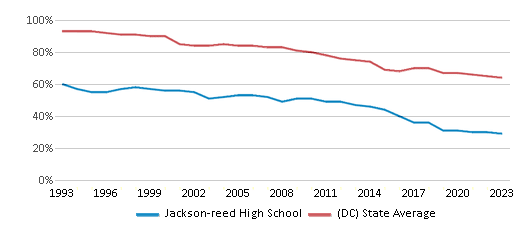
White
36%
13%
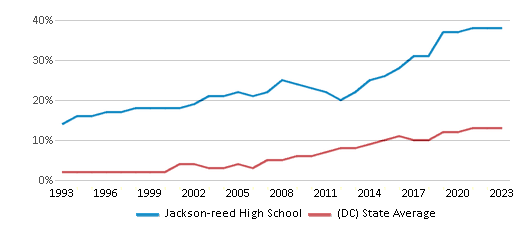
Hawaiian
n/a
n/a
Two or more races
4%
3%
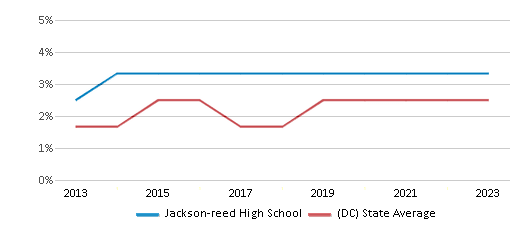
All Ethnic Groups

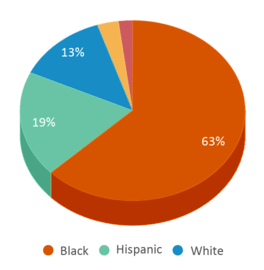
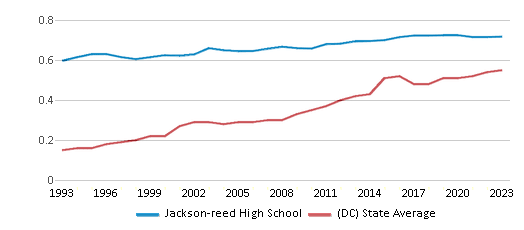
Graduation Rate
93%
76%
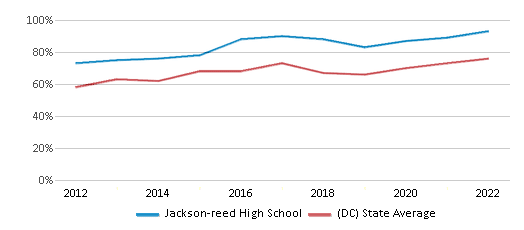
Participates in the National School Lunch Program (NSLP)
Yes
Eligible for Free Lunch
21%
49%
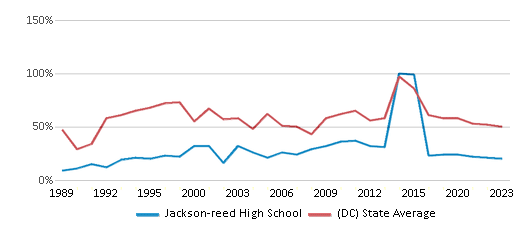
Eligible for Reduced Lunch
2%
8%
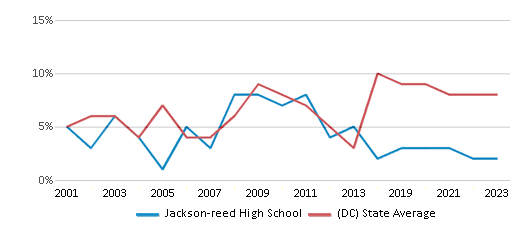
School Statewide Testing
School District Name
Source: National Center for Education Statistics (NCES), DC Dept. of Education
School Notes
- Woodrow Wilson Senior High School is a secondary school located in Washington, DC, United States.
- Wilson, which serves grades 9 through 12, is a part of the District of Columbia Public Schools.
- Dr. Stephen P. Tarason is currently the sitting principal for Wilson and has been since 1999. The school's website says "'Woodrow Wilson Senior High School, Washington, D.C.’s largest comprehensive public high school, is known for its academic excellence and for its geographic, ethnic and economic diversity'". The school's student body represents 85 countries and the students come from 40 different schools in the city. The school mascot is the Wilson Tiger, and the motto is "Haec olim meninissee juvabit", which translates to "In days to come, it will please us to remember this". It is notable that, in context in Virgil's Aeneid, the line was an ironic comment made after the characters survived a shipwreck. Woodrow Wilson Senior High is located in DC's Tenleytown neighborhood, one block off Wisconsin Avenue NW.
- In mid 2006, Woodrow Wilson Senior High School was proposed to be a charter school, but opposition from out-of-bounds students put the plan on hold. It has however a major objective of neighborhood and in-bounds interests. Woodrow Wilson Senior High School is the top performer in the non-magnet High School system in DCPS and one of the top performers in DCPS overall.
- The school serves several neighborhoods, including Georgetown, Glover Park, and Tenleytown.
- The school's demographics are as follows:
- School boundaries encompass everything west of 16th Street, NW, all of southwest Washington north of the Anacostia River, and parts of Capitol Hill southeast.
- Nearly 40 percent of the students receive free and reduced lunch benefits.
- About 89 percent of Wilson students continue their education beyond high school, with 77 percent attending four-year or two year colleges or universities. Woodrow Wilson HS was the first school in the metropolitan area to adopt and implement a four course a day, alternating even day and odd day, modular schedule.
- Aside from its academic strengths, Wilson is also known for its athletic and extracurricular programs. Not only do the Tigers maintain the only crew team among DC public high schools, but the baseball team has won more than ten consecutive city championships, and the soccer, cross country, and track teams are perennially among the best in the city.
- Wilson used to be the only public school in DC with a swimming pool, but the pool has been out of operation for the past five years.
- Famous alumni: Ray Blair; H.R., musician; Clarence Greenwood, a.k.a. Citizen Cope, musician; Emmanuel Burriss, baseball player; Darryl Jennifer, musician; Ian MacKaye, musician; Henry Rollins, musician, poet, media personality; Roger Mudd, Reporter; David Mays, Publisher (The Source); Tommy Duren, Politician, Puppeteer, Child Entertainer; Frank Rich, Editorialist, Drama Critic (The New York Times); Ian Herbert, Journalist (Washington Post Express); Adrian Fenty, Mayor-Elect of Washington, DC; Aquil Abdullah, Olympic Rower; Warren Buffett, Billionaire; DJ Spooky, musician.
Profile last updated: 02/09/2025
Frequently Asked Questions
What is Jackson-reed High School's ranking?
Jackson-reed High School is ranked #49 out of 220 schools, which ranks it among the top 30% of public schools in District Of Columbia.
What schools are Jackson-reed High School often compared to?
Jackson-reed High Schoolis often viewed alongside schools like School Without Walls High School, Benjamin Banneker High School by visitors of our site.
What percent of students have achieved state testing proficiency in math and reading?
18% of students have achieved math proficiency (compared to the 19% DC state average), while 54% of students have achieved reading proficiency (compared to the 31% DC state average).
What is the graduation rate of Jackson-reed High School?
The graduation rate of Jackson-reed High School is 93%, which is higher than the District Of Columbia state average of 76%.
How many students attend Jackson-reed High School?
1,994 students attend Jackson-reed High School.
What is the racial composition of the student body?
36% of Jackson-reed High School students are White, 28% of students are Black, 26% of students are Hispanic, 6% of students are Asian, and 4% of students are Two or more races.
What is the student:teacher ratio of Jackson-reed High School?
Jackson-reed High School has a student ration of 14:1, which is higher than the District Of Columbia state average of 11:1.
What grades does Jackson-reed High School offer ?
Jackson-reed High School offers enrollment in grades 9-12 (No virtual instruction).
What school district is Jackson-reed High School part of?
Jackson-reed High School is part of District Of Columbia School District.
In what neighborhood is Jackson-reed High School located?
Jackson-reed High School is located in the Tenleytown neighborhood of Washington, DC. There are 1 other public schools located in Tenleytown.
School Reviews
Review Jackson-reed High School. Reviews should be a few sentences in length. Please include any comments on:
- Quality of academic programs, teachers, and facilities
- Availability of music, art, sports and other extracurricular activities
Recent Articles

School-to-Prison Pipeline Persists Despite Local, State and National Efforts
Inadequate funding and resources for schools, harsh zero-tolerance discipline policies, police presence in public schools, and de facto segregation continue to create school environments in which poor and minority students have little chance of succeeding. The result is a continuation of the school-to-prison pipeline that has been commonplace in the American education system for decades, despite federal, state and local efforts to curb the problem.

How the Arts Benefit Your Children Academically and Behaviorally
Often underfunded in the past, the arts are gaining a resurgence in support as research shows benefits for children academically, along with improvements in behavior and attendance.

February 05, 2025
Understanding the U.S. Department of Education: Structure, Impact, and EvolutionWe explore how the Department of Education shapes American education, from its cabinet-level leadership to its impact on millions of students, written for general audiences seeking clarity on this vital institution.









